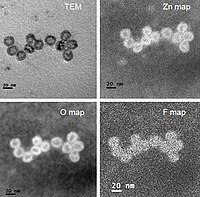
Photo from wikipedia
Abstract Structural optimization by using donor–acceptor (D–A) conjugated polymers is a promising strategy for improving the power conversion efficiencies (PCEs) of polymer solar cells (PSCs). In this study, we report… Click to show full abstract
Abstract Structural optimization by using donor–acceptor (D–A) conjugated polymers is a promising strategy for improving the power conversion efficiencies (PCEs) of polymer solar cells (PSCs). In this study, we report the best PCE of 8.9% based on PC71BM that was achieved by using a 250 nm thick active layer in an inverted device through the optimization of side chains of P(2DBDT-DTffBT) backbones. Specifically, by varying the alkyl side chain lengths and shapes in the acceptor unit of polymers, the effect of side chain engineering on photovoltaic performance was systematically studied in terms of the relationship between steric hindrance and molecular weight.
Journal Title: Journal of Industrial and Engineering Chemistry
Year Published: 2019
Link to full text (if available)
Share on Social Media: Sign Up to like & get
recommendations!